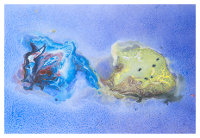Conveners
Parallel VI: G2 Strongly Coupled Theories
- Alexei Yung (Petersburg Nuclear Physics Institute)
Lev Lipatov
(Petersburg NPI)
08/09/2014, 16:30
Section G: Strongly Coupled Theories
We remind, that the high energy behavior of scattering amplitudes in QCD is described by the BFKL equation for the pomeron as a composite state of reggeized gluons. In
the leading logarithmic approximation its hamiltonian has a number of remarkable properties including its Moebius invariance, holomorphic separability and integrability.
These properties are valid also for the BKP equation...
Erich Poppitz
(university of toronto)
08/09/2014, 17:00
Section G: Strongly Coupled Theories
I will review the conjecture that the thermal deconfinement transition in pure Yang-Mills theory is continuously connected to a quantum phase transition in softly-broken N=1 supersymmetric Yang-Mills theory on R^3 x S^1. The latter is driven by a competition between various exotic ``topological" molecules, and, since it occurs in a calculable weak-coupling regime, a great deal can be learned...
Irina Aref'eva
(Steklov Mathematical Institute, Moscow)
08/09/2014, 17:30
Section G: Strongly Coupled Theories
Dual holographic approach provides a powerful tool to study the static
properties of QGP as well as its thermalization.
There are models that reproduce perfectly the static properties of QGP,
meanwhile others models are used to reproduce non-static characteristics,
for example the charged multiplicity dependence on the energy.
We propose a holographic background that reproduces at...
Michael Lublinsky
(Ben-Gurion University of the Negev)
08/09/2014, 18:00
Section G: Strongly Coupled Theories
Using fluid/gravity correspondence, we determined the (linearized) stress energy tensor of N = 4 super-Yang-Mills theory at strong coupling with all orders of the boundary derivative included. We found that the dissipative effect is totally encoded in the shear term and a newly appeared one starting from third order. In the hydrodynamic regime, we analytically obtained the stress tensor up to...
